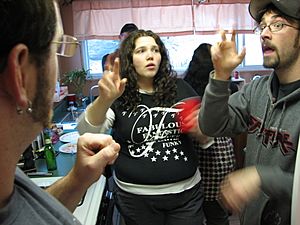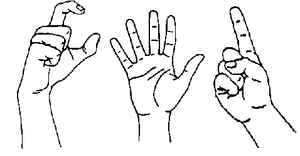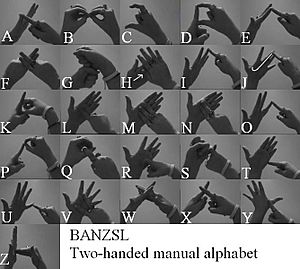Sign language facts for kids
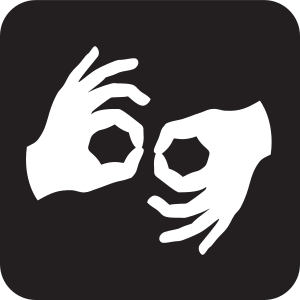
A sign language is a way of communicating by using the hands and other parts of the body. Sign languages are an important way for deaf people to communicate. Deaf people often use them instead of spoken languages. Spoken languages use sounds from the mouth and are understood with the ears. Sign languages use hands and are understood with the eyes. Deaf people can use sign languages more easily than spoken languages.
Contents
Language learning and use
Deaf people sometimes learn a sign language from their family, especially if their parents are deaf. But, most deaf children have hearing parents, so they learn a sign language from other deaf people. They may meet other deaf people at school or in the streets. Hearing people may learn to sign directly from deaf people. Or, they may learn a sign language by going to signing classes or by studying a sign language workbook, which can come with an interactive DVD.
Sometimes deaf people do use a spoken language, especially when talking with hearing people. Sometimes hearing people use a sign language with each other, rather than speaking. But, deaf people tend to use sign languages, and hearing people tend to use spoken languages.
Some deaf people can also understand spoken words by looking at a speaker's lips. This is known as lip-reading. It is hard to learn, and few people do it well. Sometimes signing and lip-reading are combined, especially when deaf and hearing people are talking to each other.
History
Sign langages have always existed in deaf communities. In ancient texts we see authors commenting about deaf people and sign language. In the western world, the first studies dedicated to sign languages date from the 17th century. In 1620, in Spain, the priest Juan Pablo Bonnet published a text about teaching deaf people to speak, using gestures as a tool. The language of signs created by Bonet was used by Abbé Charles-Michel de l-Épée, to create a fingerspelling alphabet in the 18th century. This alphabet has changed very little since then, and is used with sign languages in many countries.
The sign alphabet created by l-Épée, however, is not the origin of French Sign Language, the sign language that has influenced many other sign languages around the world. Even before l-Épée started teaching deaf people, they already used Old French Sign Language, and could read and write in French. This was a great advance, because it proved that deaf people could be educated and didn’t needed speech to think and learn.
Different sign languages
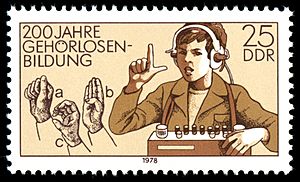
Sign languages are not universal. That means there is not one single sign language for all deaf people around the world. There are many different sign languages. Each deaf community can develop its own sign language. Usually there is a different sign language in each country. Linguists have identified at least 137 different sign languages.
Here are some well-known sign languages:
- This list could use more variety. It doesn't need to list every language. However, you can help Wikipedia by adding languages that aren't related to the ones already here.
- American Sign Language (ASL)
- Auslan (Australian Sign Language)
- British Sign Language (BSL)
- Japanese Sign Language (日本手話, Nihon Shuwa) (JSL or NS)
- Mexican Sign Language (Spanish: Lengua de señas mexicana or LSM)
- New Zealand Sign Language (NZSL)
- Quebec Sign Language (French: Langue des signes québécoise, or LSQ)
- Turkish Sign Language (TSL)
However, sign languages are not totally independent from each other. Sign languages can develop from the same source. For example, ASL, LSM, and LSQ all developed from Old French Sign Language. They are part of the same language family. Sign languages can be similar to each other. BSL, Auslan, and NZSL are very much alike. Linguists sometimes talk about them as if they are one language. They call it "BANZSL" (an acronym for "British Australian New Zealand Sign Language"). Sign languages can influence each other. They sometimes copy signs from other sign languages, the same way spoken languages copy loanwords.
Grammar of sign languages
According to the American Heritage Dictionary, signing is "a language that uses a system of manual, facial, and other body movements as the means of communication, especially among deaf people." Sign languages have their own grammar rules: syntax, morphology, phonology and semantics. Sign languages are not simply mime. They are not gestures strung together without any rules. Sign languages are real languages.
(People sometimes also use the term "sign language" to talk about a "method of communication, as between speakers of different languages, that uses hand movements and other gestures." This article is about the first use of the term "sign language". It is talking about a real language that must be learned, not just a set of simple gestures that anyone can dream up to communicate.)
A sign language is not a copy of a spoken language. For example, American Sign Language (ASL) and British Sign Language (BSL) are not copies of English. They are different from each other, even though they are both used in countries that speak English. Sometimes sign languages may copy a few elements from a spoken language, but usually they are very different. For example, sign languages often use different locations in space around the signer to represent people or objects that are being talked about. These locations are used like pronouns in spoken languages.
The main difference between sign languages and spoken languages is that sign languages use hand and body movements to form signs while spoken languages use sounds to form words. Really, each sign in a sign language is like a word in a spoken language. Both types of languages use grammar rules to combine words/signs into sentences. That's what makes them languages, and why both types of languages are different from mime or simple gestures.
Spoken words are made up of smaller pieces: individual sounds like "p" or "o". In the same way, signs are made up of smaller pieces: handshapes, movements and locations of the hands, facial expressions and other body movements. These pieces are used in different combinations to make the signs in the language Some signs are made with only one hand, and others are made with both hands. Some signs include movements of the mouth or other parts of the body; without those other movements, the sign is not correct. Other body movements are also important in the grammar. For example, in many sign languages, raised eyebrows indicate a question that has a "yes" or "no" answer.
The grammar rules of different sign languages are similar to each other, but they aren't the same. There is not a universal grammar for sign languages; each sign language has its own grammar. For example, sign languages use different handshapes to form signs; each sign language has its own set of handshapes.
Sometimes a sign looks like the object or action it represents, but this is not always true. For many signs, a person just has to learn the meaning, like words in a spoken language. It's not easy to guess the meaning from what the sign looks like. This is another thing that makes sign languages different from mime; in mime, the meaning of a gesture is obvious, it doesn't have to be learned. However, signs aren't totally arbitrary either. Once a person knows the meaning of a sign, the form of the sign can often help remember the meaning.
Fingerspelling
Besides normal signs, many sign languages use fingerspelling. Fingerspelling is also known as a "hand alphabet" or "dactylology". In fingerspelling, each letter in the alphabet of a spoken language has its own sign. Fingerspelling is a tool. People use it to spell names, acronyms and other words from spoken languages. Sometimes people do this when there is not a sign yet. Sometimes people use a fingerspelled word even when there is a normal sign for the same meaning. For example, when talking about a person, a signer might spell their name using fingerspelling. Or, they may use a "name-sign"—a special sign for that person.
Fingerspelling is not universal. It is different in different sign languages. Two sign languages may have a similar fingerspelling system. Or, their fingerspelling systems may be very different. Some fingerspelling systems use only one hand. ASL uses a one-handed system. Other sign languages use both hands for fingerspelling. The BANZSL languages use a two-handed system. There are different fingerspelling systems for different writing systems. Japanese is written with different letters than English. This means fingerspelling in Japanese Sign Language is different from fingerspelling in ASL or BANZSL. ASL uses a lot of fingerspelling. Most sign languages use less fingerspelling than ASL. Some sign languages don't use fingerspelling at all.
Writing sign languages
There is not any official way of writing signs. Some deaf and hearing people think there should be. Some have invented different ways of writing sign languages. Here are some of them.
- Stokoe notation was invented by William Stokoe. He did it for his 1965 Dictionary of American Sign Language. People have used it for a few other languages too. Few people use it now.
- The Hamburg Notation System (HamNoSys) is a technical system. Linguists use it for research on sign languages. Most of these linguists are in Europe.
- Sign Language International Phonetic Alphabet (SLIPA) is another technical system. It is intended for research.
- SignWriting was developed by Valerie Sutton starting in 1974. People can use it for ordinary day-to-day use. It works for many different sign languages.
- si5s is also intended for ordinary day-to-day use. It is a system for ASL.
- ASL-phabet is a system designed by Sam Supalla for ASL. He has used it in deaf schools.
Other users of sign language don’t think writing signs is something useful. Usually, deaf people just write the spoken language in their country. They don't try to write the sign language.
Sign languages in deaf culture
Deaf people have their own culture. It is similar to the culture of hearing people around them, but there are important differences. Deaf people have different experiences from hearing people. This makes their culture different.
Sign language is the most important part of deaf culture. Through a sign language deaf people can create a social and cultural identity for themselves. They can communicate naturally with each other. The shared sign language helps hold their deaf community together. Hearing people use spoken languages to do the same things.
Some children are born deaf. Others lose their hearing because of illness when they are very young. These children often learn how to sign and become a part of the deaf community and deaf culture.
However, some people who are physically deaf do not participate in deaf community and deaf culture. Some people lose their hearing later in life. These people usually continue to interact with hearing people using a spoken language. They do not learn to sign. They do not make friends with deaf people who sign. They depend on hearing aids, lip-reading, or writing notes to communicate with their hearing friends.
Some deaf children learn to speak and lip-read a spoken language. This is a difficult skill, but some children succeed. Also, some may have surgery to get a cochlear implant. A cochlear implant helps some deaf children hear better. It is not the same as normal hearing, but it can help them learn to speak. These deaf people can interact with hearing people using a spoken language.
The term "deaf culture" usually refers only to the culture of deaf people who sign.
Related pages
- American Sign Language (ASL)
Images for kids
-
Sign language relief sculpture on a stone wall: "Life is beautiful, be happy and love each other", by Czech sculptor Zuzana Čížková on Holečkova Street in Prague-Smíchov, by a school for the deaf
-
Young students learn some words of Lao sign language from Suliphone, a deaf artist. This was one of several activities at a school book party sponsored by Big Brother Mouse, a literacy project in Laos where Suliphone works.
See also
 In Spanish: Lengua de señas para niños
In Spanish: Lengua de señas para niños


